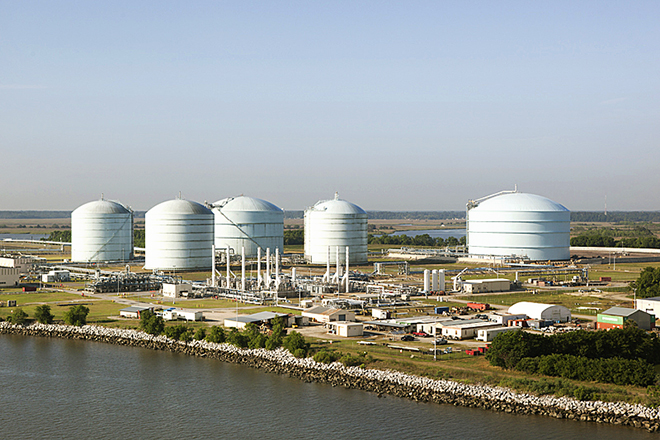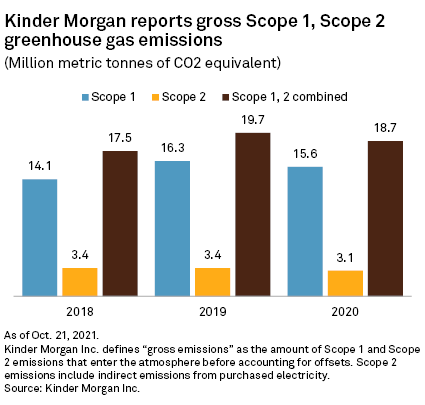
Kinder Morgan Inc. faces the challenge of decarbonizing a vast network of fossil fuel infrastructure assets that includes 70,000 miles of natural gas pipelines and liquefied natural gas and other products terminals. |
Kinder Morgan Inc. fulfilled a pledge to release Scope 1 and Scope 2 greenhouse gas emissions data by 2021, offering new insights into the carbon and methane footprint at one of the nation's largest pipeline and midstream infrastructure operators.
Among the findings in its 2020 Environmental, Social, and Governance Report, Kinder Morgan reported that combined Scope 1 and Scope 2 emissions declined 5% in 2020 from the previous year but were up nearly 7% from 2018. The data illustrated the challenges of decarbonizing a business largely built on transporting fossil fuels while identifying the company's opportunities for emissions reductions.
"This deeper analysis of our emissions and emission sources enables us to take the first steps toward establishing achievable [greenhouse gas] emission reduction targets," Kinder Morgan Vice President and COO James Holland said in an Oct. 21 press release. "It also helps us to effectively make further [greenhouse gas] reductions across our asset footprint."

Kinder Morgan has sought to address its emissions by expanding its business handling natural gas and liquefied natural gas, which are lower-carbon fossil fuels but are comprised chiefly of methane, a potent greenhouse gas. It has also invested in renewable natural gas, or RNG, as well as biodiesel, ethanol and renewable diesel. The company also noted its participation in pilot projects to advance the market for responsibly sourced gas.
In 2019, the company saw an increase in Scope 1 emissions — or emissions linked to its direct business practices — as it placed natural gas expansion projects into service. The company attributed a decrease in 2020 to lower system activity tied to the economic impacts of COVID-19.
Scope 2 emissions, which include indirect emissions tied to the electric power that Kinder Morgan purchases, ticked down to 3.1 million metric tons of CO2 equivalent after remaining steady in 2019 at 3.4 million metric tons.
The report showed methane accounting for a greater share of Kinder Morgan's overall emissions, growing from 18% of total Scope 1 emissions in 2018 to 27% in 2020. The company reported combined Scope 1 and 2 methane emissions intensity of 0.03% in 2018 and 2019, and 0.04% in 2020, below Kinder Morgan's 2025 goal of 0.31%. Methane emissions intensity is a measure of emissions for each barrel-of-oil-equivalent unit of natural gas that passes through its system.
Two-thirds of Kinder Morgan's Scope 1 greenhouse gas emissions in 2020 were tied to combusting fuel in engines and turbines to drive compressors, boilers and steam generators, and other equipment. Gas-fired combustion drivers alone accounted for 50% of scope 1 emissions.
Emissions from combustion activities declined by six percentage points since 2018, as vented emissions and unintended fugitive emissions both increased as a percent of total Scope 1 emissions from 2018-2020. Vented emissions, the second-largest source at Kinder Morgan, include intentional emissions from blowdowns during maintenance, integrity testing, and emergency activities at facilities.
Newly mandated federal regulations will require pipeline operators to develop plans to reduce both fugitive and vented emissions.
Kinder Morgan in March announced the formation of an energy transition ventures group to explore decarbonization opportunities, including carbon capture, utilization, and sequestration, or CCUS; RNG capture; hydrogen production; and renewable power generation. In the 2020 ESG report, Kinder Morgan classified renewable gas and fuel uptake as short-term opportunities. It counted developing CCUS assets and blending hydrogen into its existing infrastructure among potential five-year plans. It said building dedicated hydrogen pipelines would occur over a longer time frame.



